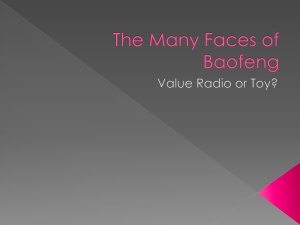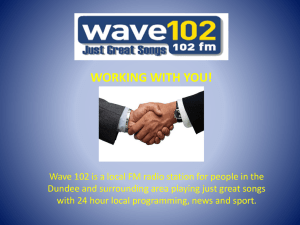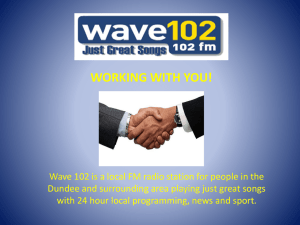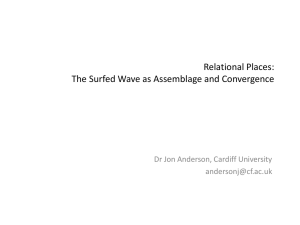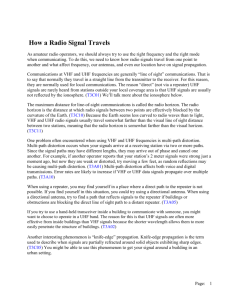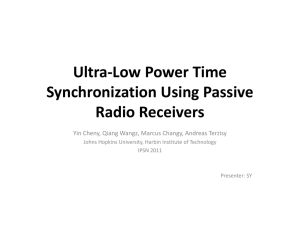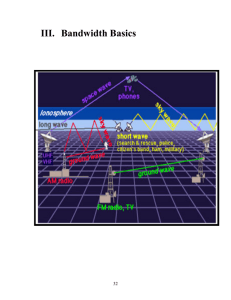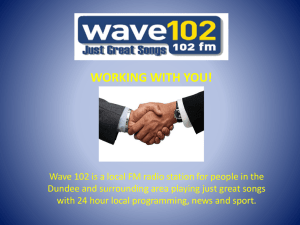GWEN-EmComm PowerPoint
advertisement
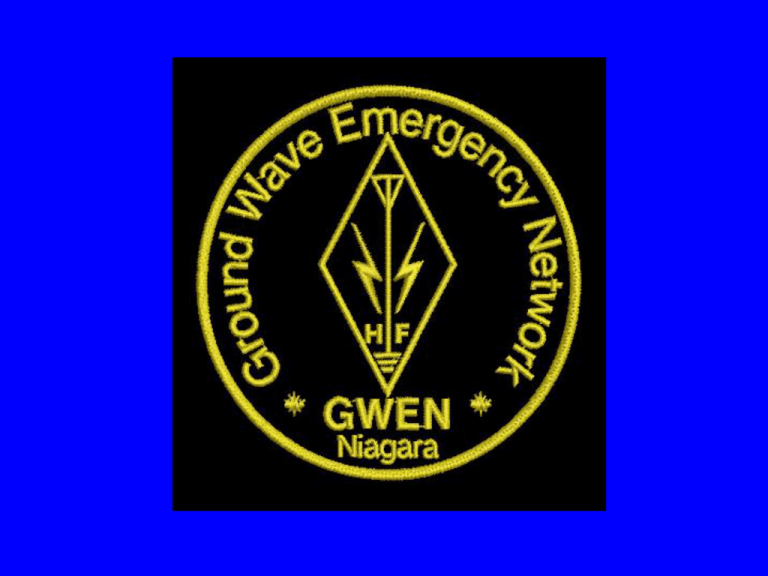
GWEN And Ground Wave Propagation What is Ground Wave? • It is a mode of propagation generated only by vertical polarization. • It is used exclusively by the broadcast industry for their transmissions. • Radio waves remain in contact with the earth. • VLF range is thousands of miles. Ground Wave Propagation is: • • • • • • • • • Best employed on the 160 and 80M bands. Ideal for 60 to 100+ mile range. Great daytime communication, low noise. Takes advantage of the “D” layer screening. Range Km= 200/(sqrt(Fmhz)). Induced currents in the ground cause tilts. Higher the freq. the more the tilt. Fresh water is akin to poor soil conditions. GWEN is immune to high altitude EMP originating from a nuclear detonation. Surface or Diffracted Wave • This is the portion of the wave that is in contact with the earth. • It’s losses are determined by the quality of the soil. • The wave tilts forward as it moves. Why Not NVIS? • Near Vertical Incident Skywave range is determined by antenna height and ionization in the upper ionosphere, and is subject to change from hour to hour ,day to day, and season to season. • Ground wave suffers little from these effects as verified by listening to an AM radio station within 100 miles of you. Ground Wave Testing •Tests were done with a portable vertical antenna 27 feet long with 8 suspended radials two feet off the ground. Peter VA3WET was the out station. •Tests were done over the period of one year at various places throughout Southern Ontario. •The tests were done at a radius of 100Kms from the base station in NOTL. •Power levels were 80W, 40W and 20W or 3dB down. NOTL Base Station GWEN •The base station was running 50 W during all testing. •A 46 foot top loaded vertical with 48, 40 foot ground radials on the surface of the soil. •An old FT 102 was used for the occasions. Results of the tests! •As expected the worst case was at the 20W levels of power. •At this level Peter was just above an S5. •The copy was spotty at times but the “S” meter remained constant while generating a constant tone so we knew we were on groundwave. •If the remote station was replaced by a base station there would have been a S9 copy. GWEN and Frequency • As the frequency increases so do the losses. • Signals above 40M tend to become useless for ground wave operation. • Vertical polarization only can be used for Ground Wave. • Horizontally polarized signals are either absorbed or reflected into the ionosphere. VHF / UHF • These frequencies are propagated in line of sight, therefore have very limited distance. • Some distance is gained by refraction or antenna elevation. • The rule is (sqrt 1.5xAh(in feet)). • Repeaters become necessary for consistent signals. ARES GWEN • If existing VHF/UHF stations are within simplex range of each other, we have a limited guaranteed communication. • This setup would produce a working link with all the cells in your area. • Still there would be no link with the outside world, that area outside of VHF/UHF range. • HF ground wave would serve to link other areas of vhf/uhf interest. • The range of one HF link is equal to five VHF/UHF links or roughly 100kms. ARES SET • All ARES cells operate on simplex to verify communications are established. • Any antenna and power adjustments be changed to guarantee those communications. • HF cells operate only on SSB or CW to keep technology to a minimum. • PSK31 tests will be performed to see if 160 Km can be established putting the London area within range of NOTL. UP and Running • When all VHF /UHF links are compliant, and 100km range established between two HF ground wave outstations. • Then you have an emergency communication system bar none. An HF Benefit • Most, but not all HF stations can and do run high power. • This can be instrumental in achieving stronger CW signals and clearer SSB reception. Service to the Community • • • • • • This is why ARES was formed. It should try to cover every eventuality. Use every resource available to it. Train its people in NTS traffic handling. Have impromptu SETs. Become involved with hospitals, shelters. If Interested! • Get together with your ARES group and discuss the possibility of your own HF link. • The dream would be to encircle all Southern Ontario with such a link from windsor to Ottawa. • Copies of this presentation are available, • Just e-mail me “ve3bbn@gmail.com” Ground Wave Emergency Network Southern Ontario Coverage Questions? Thank you for your time
